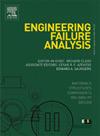Failure assessment of seam-welded pipe under fatigue and thermal loading
IF 4.4
2区 工程技术
Q1 ENGINEERING, MECHANICAL
引用次数: 0
Abstract
This paper presents an assessment of the failure of a seam-welded pipeline under fatigue and thermal loading. The investigation concentrated on analyzing several factors potentially influencing pipeline failure. Both experimental analysis and numerical simulations utilizing the finite element method (FEM) were conducted to understand potential failure modes of a seam-welded SS304L pipeline. The experimental and FEA analyses investigated various failure factors including weld defects, fatigue and thermal loading, residual stresses, and overloads. The study concludes that substandard welding procedures and inadequate post-weld treatment, coupled with elevated residual stresses in the heat-affected zone (HAZ) of the weld, were the primary contributors to failure. The paper systematically outlines the utilization of experimental and FE analyses in examining practical engineering failure instances. This approach strengthens the ability to avert failures and navigate risks with precision. Furthermore, the results highlight the critical significance of adhering to code and standard guidelines concerning pipe seam welds and post-weld treatment practices.
疲劳和热负荷下缝焊管道的失效评估
本文介绍了在疲劳和热负荷条件下缝焊管道失效的评估。调查集中于分析可能影响管道失效的几个因素。为了了解接缝焊接 SS304L 管道的潜在失效模式,本文进行了实验分析并利用有限元法(FEM)进行了数值模拟。实验和有限元分析调查了各种失效因素,包括焊接缺陷、疲劳和热负荷、残余应力和过载。研究得出结论,不合格的焊接程序和不适当的焊后处理,再加上焊缝热影响区 (HAZ) 中残余应力的升高,是导致失效的主要原因。论文系统地概述了在研究实际工程失效案例时如何利用实验和 FE 分析。这种方法增强了避免失效和精确控制风险的能力。此外,研究结果还强调了遵守有关管缝焊接和焊后处理实践的规范和标准准则的重要意义。
本文章由计算机程序翻译,如有差异,请以英文原文为准。
求助全文
约1分钟内获得全文
求助全文
来源期刊

Engineering Failure Analysis
工程技术-材料科学:表征与测试
CiteScore
7.70
自引率
20.00%
发文量
956
审稿时长
47 days
期刊介绍:
Engineering Failure Analysis publishes research papers describing the analysis of engineering failures and related studies.
Papers relating to the structure, properties and behaviour of engineering materials are encouraged, particularly those which also involve the detailed application of materials parameters to problems in engineering structures, components and design. In addition to the area of materials engineering, the interacting fields of mechanical, manufacturing, aeronautical, civil, chemical, corrosion and design engineering are considered relevant. Activity should be directed at analysing engineering failures and carrying out research to help reduce the incidences of failures and to extend the operating horizons of engineering materials.
Emphasis is placed on the mechanical properties of materials and their behaviour when influenced by structure, process and environment. Metallic, polymeric, ceramic and natural materials are all included and the application of these materials to real engineering situations should be emphasised. The use of a case-study based approach is also encouraged.
Engineering Failure Analysis provides essential reference material and critical feedback into the design process thereby contributing to the prevention of engineering failures in the future. All submissions will be subject to peer review from leading experts in the field.
 求助内容:
求助内容: 应助结果提醒方式:
应助结果提醒方式:


